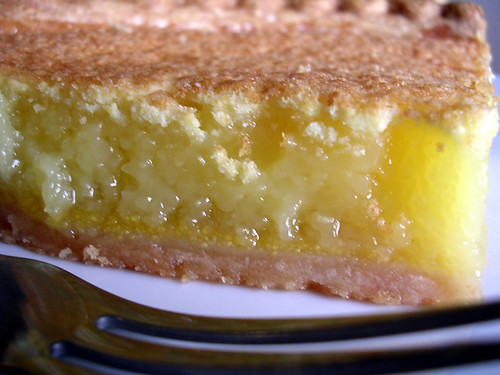Advent Day 7: Lemon Chess Pie
Lemon Chess Pie

I've never made this pie before, but it's something like glorified lemon bars. I want to eat it now.
From a cook on Epicurious.com:
"There are several theories as to how these pies came by their name. Some say that "chess" is a corruption of "chest," meaning that these pies were so rich they could be stored in chests at room temperature. Others offer a different explanation: It seems that long ago when a good plantation cook was asked what she was making, she replied, "Jes pie," which over time became "chess." Still others insist that "chess" derives from "cheese," as in the English lemon "cheese" (or curd). According to food historian Karen Hess, "cheese" was spelled "chese" in seventeenth-century England. In her historical notes and commentaries for the 1984 facsimile edition of Mary Randolph's Virginia House-wife (1824), Hess writes: "Since the archaic spellings of cheese often had but one 'e' we have the answer to the riddle of the name of that southern favorite 'Chess Pie.' "
When I lived in New York, I baked dozens of lemon chess pies for the annual Gramercy Park fund-raiser and they sold as fast as I could unpack them. From that experience, I learned to buzz up the filling in the food processor. I even grate the lemon zest by processor. Here's how: Strip the zest from the lemons with a swivel-bladed vegetable peeler, then churn it with the sugar to just the right texture. I next pulse in the lemon juice, then the eggs one by one. Finally, I drizzle the melted butter down the feed tube with the motor running. That's all there is to it."
- 1 1/2 cups sugar
- Finely grated zest of 3 large lemons
- Juice of 3 large lemons
- 5 large eggs
- 1/3 cup butter, melted
- One 9-inch unbaked pie shell
1. Preheat the oven to 325°F.
2. Combine the sugar, lemon zest, and lemon juice in a medium- size bowl. Beat the eggs in, one by one, then add the butter in a slow stream, beating all the while.
3. Pour the filling into the pie shell, slide the pie onto a baking sheet, and bake on the middle oven shelf for about 45 minutes or until puffed and delicately browned.
4. Transfer the pie to a wire rack and cool to room temperature before cutting; don't fret when the filling begins to fall. This is what gives chess pies their silken texture. Cut into slim wedges and serve.